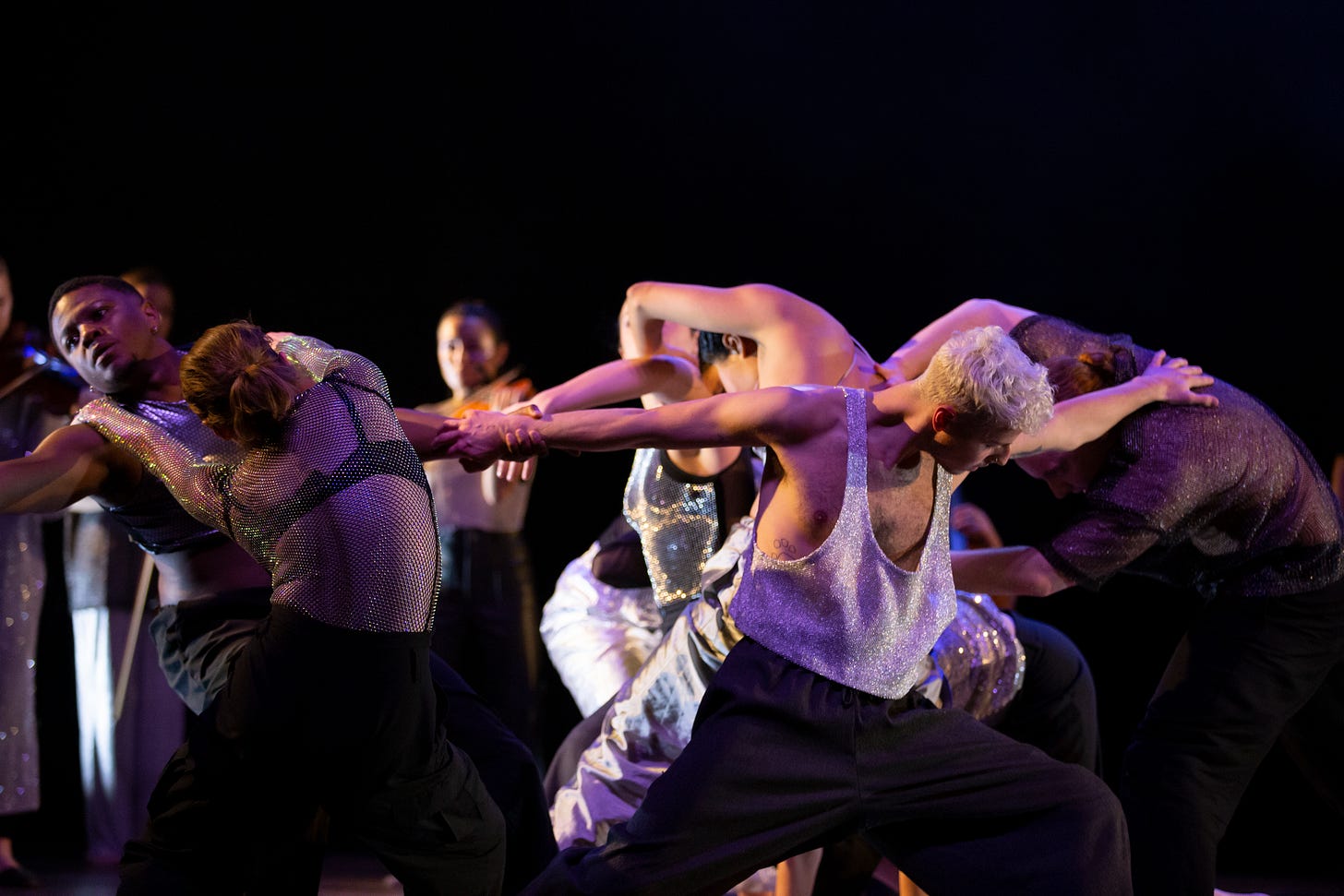photo by Kari Mosel
It is a sold out night at the Rockport Opera House - when I get there, barely on time after a family baby shower, nearly every seat in the house is full. Chairs are organized in a round, creating a performance space on the opera house floor, ignoring the stage. My friend and I aren’t able to find two seats together, but we do find two seats across from each other in the front row. We eagerly text each other from across the room as the anticipation begins to build, as the crowd around us chatters. According to the program, this chatter is about to be part of the performance. “In signal theory,” the notes explain, “a noisefloor represents the measurement of the sum of all noise sources within the measurement system.”
I notice a musician, either violin or viola, waiting in the balcony. I notice a person, wearing a sparkly top with their hair tied away from their face in a clean braid, standing behind one section of seats. Then, three performers emerge from the stage door - one sits on another’s shoulders as they slowly walk into the room, straight backed and guided by the third person, holding a violin. Another performer walks to the middle of the stage area, begins holds a lunge with arms outstretched from side to side, open palmed. Two more performers meet on the floor, close to the front row, rolling slowly with each other’s bodies.
More performers emerge, musicians settling into their seats with cellos and stand up bases. As they build the stage, the mood is set. NOISEFLOOR is an intensive collaboration of musician and mover, where performers move between the two categories throughout the night. The music was composed by Courtney Swain, with dance choreographed by heather chambers, in a process that “involv[ed] dancers in the composition process and includ[ed]musicians in little house’s movement language.”
The piece opens with an intense, ensemble dance of rigid, mostly uniform movements by the dance ensemble, establishing the emotional stakes of the performance. Following, dancer Nolan Eisenhaur gave a rolling, lyrical solo, sweat flinging from the tips of his hair as he surrendered his body into elegant turns. The language of the piece unfolded - solos, duets, and small ensemble dances blooming out of each other, with bright, taught music from the string ensemble carrying the movement.
Each individual person - twelve musicians and eight dancers - brought this collaboration to the performance with their full self. Movements were punctuated with strong, athletic breaths that become a part of the composition. When “scenes” transitioned, musicians moved (often aided by the dancers) into different formations, being foregrounded and embedded in the performance at different times, often becoming a part of the movement. There was one moment where, as a new sequence was taking shape, I saw two performers connect with each other, and their faces broke out into proud, warm smiles.
As the dancers are not quite “in character” or “telling a story” but instead, giving a performance, it was exciting to see what each performer brought to the show. Dancer Drew Lewis dances as though each movement is a question he’s asking his body. Isabel Hunter Ball looks the limits of her body and when she finds it, will hold herself there. Mia Muntu holds the dance, inside and outside of her body.
There were stunning set pieces that introduced repeated movements, building a vocabulary of feeling for me as an audience member. In the early half of the show, lead by dancers Kylie Grossman and Isabel Hunter Ball, that included Grossman dancing with both of her fists held firmly over her eyes. She is unable to move them even as she struggles against them. The rest of the dance company moved together in two groups on the floor, resting in swirling piles of bodies. In frustration Grossman pulls dancers out of their piles, only for them to be effortlessly absorbed by the group. It is Ball who notices the pattern, and opens the group dance up to include Grossman, who embraces and resists inclusion as the rest of the ensemble moves with and around her.
Some dance, even queer dance, is incredibly gendered, with one performer occupying the lifting, supporting role and the other partner soaring in lyrical heights. One brilliant and liberating aspect of NOISEFLOOR is that these pairs were queered in a more radical way - beyond having incredible same-gender duets, there are mixed-gender duets in NOISEFLOOR that rise about binary dancer’s roles. These moments allow the viewer to escape assumptions about the subtext of dance, create space for new emotions in the way that the audience interacts with the piece. One duet close to the end of the performance especially filled my heart with a queer sense wonder - it was a gift to witness the lifts in the duet between Maddy Joss and Nolan Eisenhaur. While it was happening, I wanted to burst into whoops.
I think that really great performing arts experiences give you the opportunity to move through an emotional process with a lot of clarity - for me, a great show leaves me with a deeper understanding of myself. NOISEFLOOR stacks up with the great performancs that I’ve been to in my adult life - next. to Sigur Rós and Godspeed You! Black Emperor, for some context on my taste. It gave me the space to think about movement, about relationships with others, about my relationship with my body. I left NOISEFLOOR feeling certain that dance is the medium that will lead us through the challenges of the twenty-first century. We have plenty of words and images. What we need is something beyond, something that moves us out of our minds and into our bodies, into interaction with the bodies of others, into expression instead of performance.



